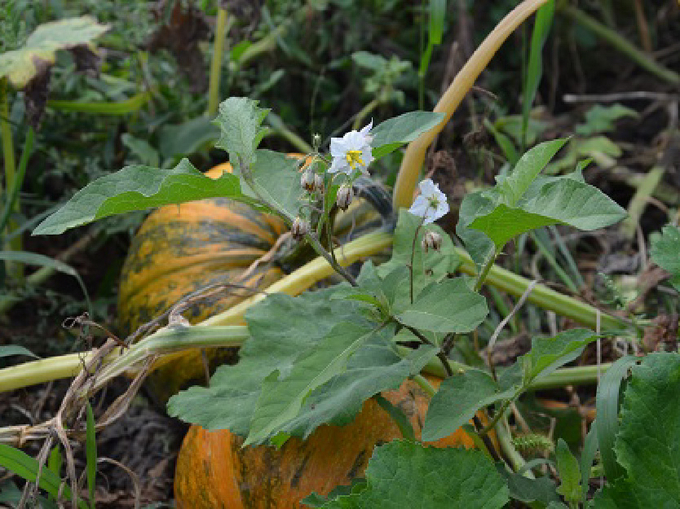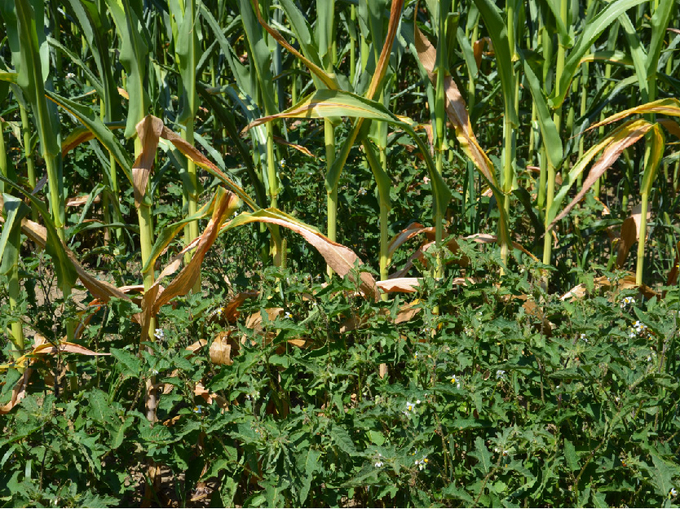Horse nettle
Solanum carolinense
Appearance
Horse nettle grows up to 120 cm tall, has stems and leaves with hard, thorn-like spines, and has purple to white flowers (July/August). In late fall, roundish, 8-20 mm, yellow to yellow-orange berry fruits ripen, each of which may contain 40-170 seeds. The plant has a characteristic root system consisting of a taproot and horizontally growing roots. These run to soil depths of up to 45 cm and grow several meters long.


Distribution

The plant originates from the Gulf States of the USA and is presently found there from Florida in the south to the north in Ontario (Canada). The first occurrence of the species in Austria is in all probability in Styria. There the species was observed several times from 1998 onwards at the edge of a cornfield in the locality of Großklein. The horse nettle was later described in Pischeldorf (Carinthia) in 2004. The current occurrences of horse nettle are limited to local, isolated populations in Styria and Carinthia, although a small-scale spread in Styria (Leibnitz area) has been observed. There are also occurrences in neighboring countries, including Italy and Germany.
Propagation and transmission
The plants spread vegetatively by rhizomes and generatively by seeds. Due to the meter-long, horizontally running roots, the plant can cover a large area within a few years. Agricultural machines break up the root system during soil cultivation and thus carry away rhizome pieces within the field area (these have an enormous regenerative capacity: root pieces > 2 cm can regenerate). Longer distance spread occurs through animals consuming the fruit, rhizome pieces in soil material adhering to agricultural machinery, and contaminated seed from infested cropland. Modeling has shown that horse nettle finds a favorable climate on almost 73% (equivalent to about 19,950 km2) of the agricultural land in Austria and is able to establish itself.
Economic importance
Horse nettle is a significant weed in many agricultural crops and grasslands because it has many characteristics of an "ideal" weed and invader (i.e., high seed production & regenerative ability). In addition, sufficiently effective herbicides are not available in most crops (including oilseed squash, potato, and soybean) in Austria. Mowing before flowering, single-plant treatment with nonselective herbicides, and cultivation of competitive crops (corn) can suppress horse nettle. Spread of seeds or root fragments to other areas should be avoided at all costs.


Prevention and control
- It is important to locate and contain emerging populations as quickly as possible. Observations show that infestation of a field often occurs from the edge of the field (roadside), so attention should be paid here.
- Very small populations may still be removed by hand (digging), although the root system is very deep, or controlled with spot treatment.
- Information on herbicide efficacy is scarce. In experimental studies, glyphosate and the active ingredient combination tritosulfuron + dicamba, for example, had a suppressive effect (> 80 % efficiency) (see list of plant protection products approved in Austria).
Specialist information
Publications
Follak, S., 2019. news on the horse nettle. The plant doctor 72(9-10), 22-23.
Follak, S., 2020. distribution and small-scale spread of the invasive weed Solanum carolinense in Austria. EPPO Bulletin 50, 322-326. DOI: 10.1111/epp.12644.
Follak S., Chapman D., Schwarz M., Essl, F.,2023: An emerging weed: rapid spread of Solanum carolinense in Austria. BioInvasions Records 12, 649-658.
Last updated: 08.11.2024
automatically translated